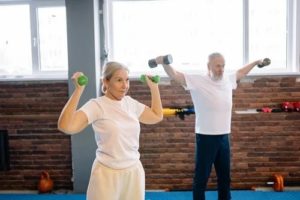Your doctor keeps reminding you that neuroplasticity is going to get you recovered. Did your doctor get you recovered enough to do aerobic exercise? So do you need neuroplasticity first or aerobic exercise? Why the fuck doesn't your doctor know exactly how to get you recovered?
Laziness? Incompetence? Or just don't care? No leadership? NO strategy? Not my job? Not my Problem?
Regular Aerobic Exercise May Induce Neuroplasticity in Older Subjects
Written by Taylor Woosley, Staff Writer. Results of a 12-week treadmill exercise training intervention of 33 subjects (16 experiencing mild cognitive impairment and 17 with intact cognition) shows that exercise training significantly increased within-network connectivity for the default network mode of all participants (p = 0.008).
 By 2030, an estimated one in five Americans will be 65 years or older1. The ageing brain is vulnerable to inflammation, with circulating pro-inflammatory factors further promoting cognitive decline2.
As we age, lifestyle interventions can target modifiable mechanisms of
cognitive and brain changes, thereby helping improve cognitive
functioning3.
By 2030, an estimated one in five Americans will be 65 years or older1. The ageing brain is vulnerable to inflammation, with circulating pro-inflammatory factors further promoting cognitive decline2.
As we age, lifestyle interventions can target modifiable mechanisms of
cognitive and brain changes, thereby helping improve cognitive
functioning3.
There is increasing evidence that exercise training may help to maintain optimal cerebrovascular function and prevent or slow the development of cognitive impairment4. Previous systemic reviews suggest that, in older individuals, exercise can benefit functional and structural network integrity5. The neuroprotective effects of exercise may be mediated by increases in brain-derived neurotrophic factor, insulin-like growth factor-type I, and vascular endothelial growth factor, promoting changes in brain areas important for memory and executive function6.
Won et al. conducted a prospective intervention study to investigate the effects of exercise on within- and between-network connectivity in older adults with intact cognition (CN) and those diagnosed with mild cognitive impairment (MCI). Subject inclusion consisted of older individuals engaging in moderate-intensity physical activity for less than three days a week for the six months preceding the study. Neurocognitive testing was performed on participants and included the Rey Auditory Verbal Learning test (RAVLT), the Controlled Oral Word Association Test (COWAT), and the Wechsler Memory Scale Logical Memory subtest (LM) which were completed before and after a 12-week intervention. Furthermore, subjects partook in a modified submaximal exercise test at baseline and at week 12 to measure heart rate reserve (HRR), along with heart rate (HR) and blood pressure.
The exercise intervention component consisted of subjects completing a supervised treadmill walk. An HR monitor was worn during each session to monitor exercise intensity. The exercise duration, intensity level, and weekly frequency increased gradually until subjects were walking 30-minutes per session for 4 days per week. During weeks 5-12, exercise intensity was at 50-60% of HRR and a 10-min warm-up and 10-min cool-down was also included. Subjects completed MRI scans to collect information on resting-state functional magnetic resonance imaging (fMRI) data and the scans were further used to define functional network nodes. Of the brain networks, three core large-scale networks, the default mode network (DMN), the frontoparietal network (FPN), and the salience network (SAL), were analyzed. Average functional connectivity (FC) was calculated within and between the DMN, FPN, and SAL.
Independent t-tests or Fisher’s exact tests were utilized to analyze baseline demographic and cognitive test performance differences between groups (MCI versus CN). Repeated measures ANOVAs were utilized to compute the main effects of Time, Group, and Group-Time interaction on the functional network connectivity metrics and cognitive performance outcomes. A total of 33 participants were included in the final analysis (16 MCI and 17 CN; mean age = 78 years). Significant findings of the study are as follows:
- A significant main effect of Time on LM task performance was observed, with consistent improvements in the LM immediate recall [F(1,28) = 6.836, p = 0.014, η2p = 0.196], LM delayed recall [F(1,28) = 4.677, p = 0.039, η2p = 0.143], and LM recognition [F(1,28) = 8.947, p = 0.006, η2p = 0.242] after exercise.
- Exercise training significantly increased within-network connectivity from before to after exercise training for the DMN (DMNW) [F(1,31) = 7.963, p = 0.008, η2p = 0.204] and SAL (SALW) [F(1,31) = 6.941, p = 0.013, η2p = 0.183] across participants.
- Exercise training-related changes in the SAL within-network connectivity (∆SALW) explained 22.1% of the variance in ∆LM immediate recall residualized change score [R = 0.471, R2 = 0.221, p = 0.009].
Results of the study show that a 12-week exercise training intervention significantly increased the within-network FC of the DMN and SAL. Additionally, increases in the functional connectivity between the three major networks of the brain were noted after exercise training. Study limitations include the lack of a control group and the small sample and homogenous characteristics of subjects.
Source: Won, Junyeon, Kristy A. Nielson, and J. Carson Smith. “Large-Scale Network Connectivity and Cognitive Function Changes After Exercise Training in Older Adults with Intact Cognition and Mild Cognitive Impairment.” Journal of Alzheimer’s Disease Reports Preprint (2023): 1-15.
© 2023 – The authors. Published by IOS Press. This is an Open Access article distributed under the terms of the Creative Commons Attribution-NonCommercial License (CC BY-NC 4.0).
Click here to read the full text study.
Posted July 3, 2023.
No comments:
Post a Comment